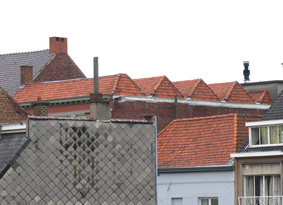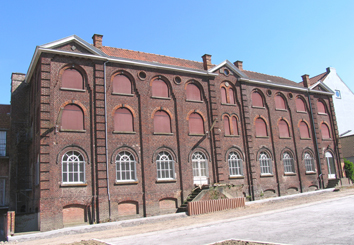Living With Industrial Heritage In Ronse’s City Centre
Former factory buildings, typical alleys, Flanders’ first social houses, mansions and managers’ dwellings with an extremely varied and sometimes even extravagant architecture, exceptional Art Deco countryhouses… If you wander around Ronse, you simply cannot miss them! And you will also understand the city’s major challenge: how can it continue to develop without destroying its unique past? Together with the city of Ronse, the Ename Center is working on a project in order to define a high-quality heritage policy around this intricate matter, the main focus being on local involvement and awareness-raising.
 The nineteenth and twentieth centuries’ textile industry did not only thrive in Ronse. It was typical of many cities in Flanders, such as Ghent and Aalst. What is unique about Ronse is that the textile industry blended in wonderfully well with the city, and that this fusion still determines the city’s character today. The many factory buildings and depots with their typical sawtoothed roofs that can be found in nearly every street, bear witness of this.
The nineteenth and twentieth centuries’ textile industry did not only thrive in Ronse. It was typical of many cities in Flanders, such as Ghent and Aalst. What is unique about Ronse is that the textile industry blended in wonderfully well with the city, and that this fusion still determines the city’s character today. The many factory buildings and depots with their typical sawtoothed roofs that can be found in nearly every street, bear witness of this.
At the end of the 19th century, major factory blocks and numerous small-scale family businesses sprang up like mushrooms. Just before the Second World War, the small city of Ronse hosted no less than 536 factories of various sizes. Because of the worldwide textile crisis, the city’s economic activity faded quickly and Ronse had to deal with socio-economic problems for the next couple of decades. In het post-war era, Ronse could hardly develop and innovate. That is also why today the city could keep its unique patrimonium.
 Typifying Ronse’s industrial heritage are the large number of working-class areas, characteristic alleys, managers’ residences and other buildings that can be linked to the city’s industrial activity and that have been preserved to this day. It gives rise to a unique mix of different types of buildings and neighbourhoods, which reflect the various aspects of the industrial life in Flanders from the 19th century until the 1960s.
Typifying Ronse’s industrial heritage are the large number of working-class areas, characteristic alleys, managers’ residences and other buildings that can be linked to the city’s industrial activity and that have been preserved to this day. It gives rise to a unique mix of different types of buildings and neighbourhoods, which reflect the various aspects of the industrial life in Flanders from the 19th century until the 1960s.
The city of Ronse has to find creative solutions for the future use of many of these industrial buildings. The problem of unoccupied and run-down warehouses and factories has to be tackled.
As a first step in this project, The Ename Center has started to draw up an inventory of the industrial buildings in the heart of the city centre. The results of this stock-taking will be useful for urban planning purposes and it will be a starting-point to involve and inform the public.
Back to newsletter
